November 11th 2008 marked the 90th Anniversary of the Armistice which brought to an end the Great War. The War had lasted more than 4 years but at 11.00am on Sunday 11th November 1918 the guns fell silent and the shooting stopped. There wasn't a community anywhere in the whole of the UK which hadn't been affected by this war in some way; most usually by the loss of husbands, sons, brothers and fathers. A look at Rushden's War Memorial shows many such names; men who gave their lives for a cause in which they believed.
One of those men was Company Sergeant Major Herbert William Bryant. His story is typical of so many of these Rushden men; yet it is a story which also ranges further afield than Rushden.
CSM Herbert William Bryant
No.6338, 'C' Company, 1st Battalion Northants Regiment, 2nd Brigade, 1st Division : Died of Wounds: 16th January 1915, near La Bassee.
Company Sergeant Major H W Bryant was a soldier reservist in Britain's Regular Army. His life and career provide a clear and individual illustration so typical of the infantry men in the British Expeditionary Force in those early months of war. There would have been many men in that small but efficient army of "Old Contemptibles" who could identify with his family background, his domestic and personal circumstances, his military service record over a number of years, his mobility and even to his death to a sniper's bullet on a cold, wet, winter's day in a front line trench in Flanders.
When he enlisted at Northampton Road, Higham Ferrers on 8th March 1901, into the Army Medical Corps for 3 years service plus 9 years with the National Reserve, Herbert was a slim young man of 19 years, 2 months. He weighed exactly 8 stone and stood 5'4" tall, with a chest measurement of 32" expanding to 33". He was described as having a fresh complexion, grey eyes, brown hair and with an identifiable scar on his right eyebrow. Such features had to be recorded for future identification purposes if required after battle. Herbert stated his religion to be Church of England and he gave his home address as 5 Pemberton Street, Rushden. However, Rushden was not his home town for he had been born in New Street, Wellingborough on 9th January 1882.
He was the fourth son of Thomas, a shoe riveter, and Esther (nee Brawn) who, by 1890, had moved their family to Rushden where they lived initially at 3 Queen Street before moving to 5 Pemberton Street.
Herbert attended Alfred Street School. His older brothers (Thomas, Benjamin and Frank) were all born in Wellingborough and he also had 2 younger brothers; Charles born in Wellingborough and Horace born in Rushden; along with an older sister Helena born in Wellingborough and two younger sisters; Jessie born in Wellingborough and Kate born in Rushden.
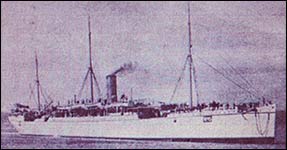 |
|
SS "Dunera"
|
|
By 11th March 1901, Herbert Bryant had transferred to the Northamptonshire Regiment and was based at the Regimental Depot in Northampton. After basic training there and at Portland in Dorset, he was posted to the 2nd Battalion Northants Regiment from 18th April 1902 and went with them aboard the troop transport ship SS "Dunera" to South Africa for the final actions of the Boer War.
As a result, he qualified for the Queen's South Africa Medal with 2 Clasps ('Cape Colony' and 'S.A.1902'). During his time in South Africa he was promoted to Lance Corporal and then Corporal and received his Good Conduct Badge. However, he did also spend three weeks in hospital at Pretoria with tonsillitis and then blotted his copybook by being absent without leave on 17th April 1904 for which he was severely reprimanded.
On 16th May 1904 the 2nd Battalion Northants embarked for home where back in Aldershot, Cpl Bryant requested to extend his regular army service to complete 8 years, plus 4 years with the Reserve. He was also awarded the 3rd Class Education Certificate but there were obviously some issues in his personal life because on 18th November and again on 27th November 1904, he went absent without leave. In each case he was severely reprimanded and forfeited pay but these punishments were not heeded because on 29th April 1905, he was tried by Regimental Court Martial for being AWOL for the fourth time. As a result, he forfeited his Good Conduct Badge, lost pay and was reduced to the ranks. From this time onwards, Private Bryant was employed for the next four years in the regimental shoemakers' shop. He seemed to have got things sorted out for he regained his Good Conduct Badge in 1906, had his good conduct pay restored and was awarded his second Good Conduct Badge in 1907.
From the years 1907 to 1910 inclusive, the 2nd Battalion Northants formed part of the Colchester Garrison in Essex, being based at Hyderabad Barracks and it was there in April 1908 that Pte Bryant was admitted to hospital with a contusion to the right knee. He was hospitalised for three weeks. Whilst at Colchester, he gained his 1st Class Musketry Certificate and played football regularly for the 2nd Battalion football team (hence the knee injury?). It was obvious that his years in the army had brought physical development for, though he hadn't grown in height at all, his chest expansion was now 36"- 38".
On 7th March 1909, Pte H W Bryant was transferred to the Army Reserve on being discharged at Colchester from the 2nd Battalion Northants after 8 years regular service. "Reservists" undertook to rejoin the army in an emergency and, for being available if required, received seven shillings (i.e. 35p) per week. Herbert's transfer document stated that he was a "good, very clean, smart soldier" who intended to pursue a trade as a shoemaker back in Rushden, where he was going to reside at 99 Glassbrook Road, the home of his older brother Ben.
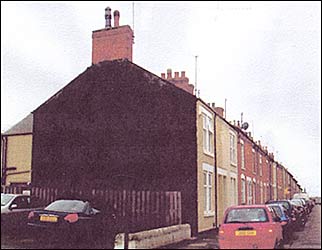 |
( left) 99 Glassbrook Road, with the black painted side wall.
(right) 19 Magdalen Street, Colchester is probably similar to No. 20 which no longer exists.
|
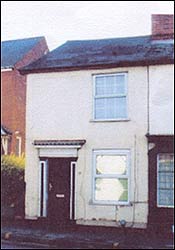 |
Herbert had also found his time in Colchester rewarding in other ways for later in 1909 on 11th October he was back in the town to marry Ethel Victoria Elsden. Ethel had been born in 1892 in Penge, Surrey; the eldest daughter of George, a railway carman, and Elizabeth. It may well have been Ethel's father's job which took the family to Colchester where they lived at 34 Magdalen Street, very near to the railway station.
In 1910, Herbert and Ethel's daughter, Kathleen Victoria Bryant, was born in Colchester at 20 Magdalen Street, the new home of Ethel's parents. This house no longer exists having been cleared along with others to make way for a bus station, but was probably similar in style to 19 Magdalen Street. Soon afterwards, the Bryant family moved to Northamptonshire where they lived initially in Higham Ferrers. Two further Bryant children were born there; Herbert William Thomas in 1911 and Richard William George in 1913. By 1914 the family was living in Sartoris Road in Rushden and Herbert was working at James Hyde's Boot Factory in Glassbrook Road, Rushden where he was known as "Chick" to his workmates. He had also renewed his army reservist status.
When Germany invaded Belgium in August 1914, Britain's declaration of war meant that on 5 August 1914 Pte H W Bryant was mobilised from the Reserve. He reported to the 3rd Battalion Northants where his military experience was put to good use training new recruits and recalled reservists at Northampton Depot and also in Portland, Dorset. Promoted to Corporal/Acting Sergeant he was then later confirmed as Sergeant on September 1914, the day he was posted to the 1st Battalion Northants. This regular battalion was already in France, having been there since 13th August 1914, so Sgt Bryant was probably sent out with a draft of men as reinforcements. They arrived at Le Havre on 12 September 1914 which meant that Sgt Bryant qualified for the 1914 Star Trio with Clasp, as his medals card shows.
Pte R Denton of 'C' Company 1st Battalion Northants wrote home to his parents in Rushden in October 1914; within his emotive letter he included a reference to Sgt Bryant - "Dad, your shopmate "Chick" Bryant is Sergeant over me and he is alright too I can tell you .... I often wish I was at home. In the mornings when you wake up it is terribly cold... We also have plenty of marching to do and you lay down and drop off to sleep at once."
Once Sgt Bryant had departed, his wife Ethel and their three young children left Rushden and moved back to her parents' house at 20 Magdalen Street, Colchester. It was there that she was to receive the news of his death. She had not probably heard of his promotion to acting Company Sergeant Major as this had happened only three days before he was killed by a sniper's bullet on 16th January 1915. The 1st Battalion War Diaries record this day as being "a quiet day" in the front line trenches east of Cuinchy, near La Bassee. Perhaps by the normal standards of that time it was, but for CSM H W Bryant, his family, and for those who were with him at the time it was more than this, as correspondence and reports were to show.
The first Ethel Bryant knew of the death of her husband, the man she called "Chick", was when she received a letter from her sister-in-law, Mrs Helena Bridgement of 101, Glassbrook Road, Rushden. Mrs Bridgement had three sons serving in the army as well as her husband, Frederick Bridgement. On Friday 22nd January 1915, she had received a postcard from a Pte Magee - "I am sorry to send you the sad news that poor "Chick" met his death on January 16th. Knowing the family so well I thought it my duty to let you know ". Mrs Bridgement at once sent a letter to Ethel, her sister-in-law, in Colchester, with this sad news, as did others. Ethel did not receive the official War Office Telegram until 17th February 1915, so in the interim period all the news she received came from soldiers and family sources. Ethel responded on Monday 25th January 1915 to another sister-in-law who had obviously also been in touch; Mrs C Bryant of 86 Cromwell Road, Rushden - "The news leaves me broken hearted. It was the first news I received about my dear husband when I got your letter on Saturday afternoon and I thought I should have gone mad. On Sunday morning (i.e. the 24th January), I received a very nice letter from Sgt Chapman telling me of my husband's death and how it happened. He said that my husband received a soldiers' burial and that his death was instantaneous. Oh poor "Chick" - a good man to meet a death like this. It will drive me mad, I am sure, for he was such a good husband to me and a good father to his little ones, and I can't realise it is true. I shall very likely come to Rushden after a while and then I can show you the letter I had. It appears that "Chick" and this Sgt Chapman became true friends when they were called up (from the Reserve). They went into battle side by side and they decided that if anything happened to one or the other, whichever was left should write and let the wife know, and he said it was his greatest sorrow to write and tell me, for he said that he and "Chick" were the greatest of chums. I don't know whatever I shall do without him - it has fairly broken me up, I can tell you. I wouldn't have cared so much if I could have seen him, but it was his luck that he could not get leave. I must thank you very much for consoling me in this sad bereavement. I hope I shall be able to come and see you soon, as it will ease my mind to know I have got some good friends, for I have lost one of the best, for he was a thorough good man", (as reported in the "Rushden Echo", Friday 5th February 1915).
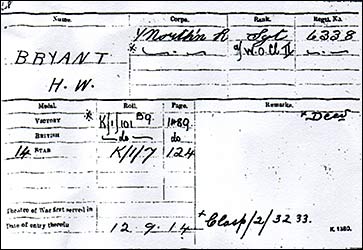 |
In another letter to Mrs Bridgement, the newly widowed Ethel stated that CSM Bryant and Sgt Chapman were out on a sniping expedition when something had attracted her husband's attention and he had put his head above the level of the trench and at once had received a bullet through the brain, death being instantaneous. The "Wellingborough News" of Friday 29th January 1915 reported "They were out sniping one day, when something attracted Bryant's attention from behind and he cautiously put his head above the parapet of the trench. Almost immediately a bullet pierced the poor fellow's head and death was instantaneous...." Both "Soldiers Died in The Great War" and CSM Bryant's Medals Index Card state that he died of wounds and no fatality incident is recorded in the Battalion War Diary for that day. It was usual for letters home to reassure relatives and report that death had been clean and instant, but further evidence from witnesses of the incident did in fact suggest that this had been the case, even though there were discrepancies in some of their accounts. (It should be remembered that in these early months of the war the infantry wore soft caps as steel helmets had not then been issued).
For example, the "Wellingborough News" of Friday 19th February 1915 carried an account from letters sent by a Sgt Steel to his brother in Rushden which stated - "Yes, it is quite true about poor "Chick" going under. I can tell you I felt quite upset when I saw him fall dead in the trench, for I was not more than four yards away from him when he got killed. I tell you exactly how it happened, in the morning Chick and I stood talking together in the trench, chiefly about Rushden we walked along the trench together when Chick had a look over the trench and said "hand me a rifle, there's a couple of Germans working against the bridge, digging. I'll see if I can knock one of them over". Well, he had a shot or two and wounded one of them. He then got up to have a look for the other German when "ping" came a German bullet and poor old Chick dropped back in the trench dead, shot through the head, the bullet entering just above the right eye. Our Captain when told of it was very upset at the loss. Well, we covered him over with a waterproof sheet and he was buried just in the rear of the trench in the evening ". The "Rushden Echo" of Friday 19th March 1915 quoted an unnamed source as saying - "I was actual witness to the death of "Chick" Bryant. He had only just told a chap not to expose himself on account of the German snipers, and then came past me with a cheery word. About 2 or 3 yards beyond he stood up to speak to an officer. Bryant's head was just a few inches above the level of the ground. Before he had stood a minute a bullet, evidently from the rifle of a German sniper, went right through his head. He fell straight down and did not utter a sound. He was buried near some brickyards". Evidently, a wooden cross was placed on the grave and a Cpl. Farmer, also in 'C' Company, went back to the local village ruins to get some flowers. There he found in the cemetery ruins two wreaths which he brought back and which were placed on CSM Bryant's grave.
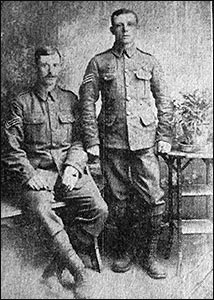 |
|
CSM Herbert Bryant (standing)
Sgt Hayward seated.
|
|
It was not unusual in those early uncensored months of the Great War for incidents and fatalities such as CSM Bryant's to be well publicised in the local press and parish magazines of the deceased's family. Often photographs, submitted by the family, would accompany the reports. The "Kettering Leader" for 5th February 1915 carried a picture of "Chick" Bryant with a fellow NCO whom it wrongly labelled as Sgt. Chapman. It was in fact a Sgt. Hayward and it was Sgt. Chapman himself who wrote to the newspaper to correct the error.
As a contrast to the extensive reports in the local Northants Press, CSM Bryant's death was not reported fully in the local newspapers in Colchester. Perhaps Ethel was too distressed and confused; perhaps she was too busy with the children where the eldest was only four years old; perhaps the Colchester press was only interested in reporting on the local regiments; but whatever the reason no full details appeared in the Colchester papers. There was only a short rather curious item relating to his football prowess;
Sergt.-Major H. W. BRYANT who was a well-known member of the 2nd Northamptons' football team when that battalion was quartered at Colchester, has been killed in the trenches in Flanders. He was a thorough sportsman, and as such was extremely popular with Colchester footballers.
|
The regimental administrative wheels turned only slowly. Ethel continued to receive the separation allowance of one pound, one shilling and two pence per week plus the five shillings and ten pence which CSM Bryant had allotted from his weekly pay for her (i.e. a total of twenty seven shillings i.e. £1.35p) but these ceased from 9th August 1915 when she received a widow's pension of one pound, one shilling and sixpence (i.e. £1.7½p) per week for herself and the three children; nearly £56.00 per year. As late as September 1917, the widow was writing to the War Office querying why she had still not received her husband's personal possessions which should have been recovered from his body. In May 1919, Ethel confirmed she was still living at 20 Magdalen Street, Colchester when Warley Records in Essex wrote to her requesting confirmation of her postal address as CSM Bryant's War Medals were due to be sent to her.
After the war, when concentration cemeteries were being organised by the Imperial War Graves Commission, CSM Herbert William Bryant's body was never found or identified. The area where he had been buried was repeatedly fought over, dug and shelled in the intervening four years. At home his name is now commemorated on the Roll of Honour in Colchester Town Hall and on the Rushden War Memorial.
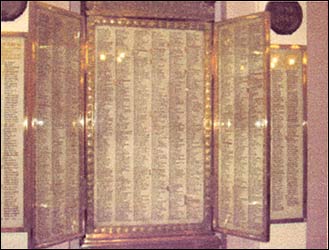 |
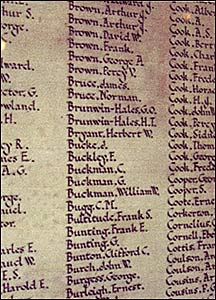 |
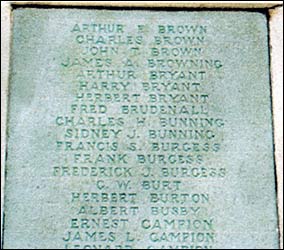 |
|
The Colchester Memorial (above, and right) the panel where Herbert's name is inscribed.
|
The panel on Rushden's War Memorial showing Herbert's name.
|
In France, his name can be seen on Panel 28 of Le Touret Memorial to the Missing which stands at the eastern side of Le Touret Military Cemetery along the Bethume to Armentieres road. The memorial commemorates more than 13,000 men who died from August 1914 to early September 1915 in this area and who have no known graves.
CSM Herbert William Bryant had only just reached his 33rd birthday when he gave his life for "King and Country" but sadly that is not the complete end of the story for Rushden.
Also listed on the Touret Memorial to the Missing are four names; Cpl F Farmer who found the wreaths for Bryant's grave and was himself also shot through the head by a sniper five days later on 21st January 1915; and Sgt H Hayward and Sgt P Steel along with Pte F Magee were all killed on 9th May 1915 at the Battle of Aubers Ridge. The husband of Ethel's sister-in-law, Pte F Bridgement, was also to die in action killed by machine gun fire on 8th November 1918, just three days before the Armistice. The two latter names are also on Rushden War Memorial. Sgt Chapman, Bryant's chum, appears to have survived the war and it also seems from a cursory look at records that all the other Bryant brothers may have survived.
|
|
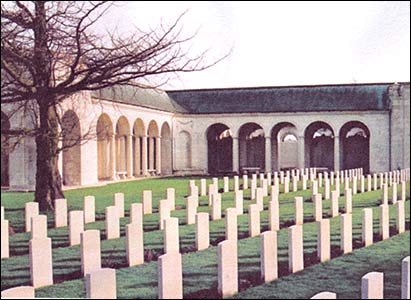 |
Remember all these men who died and all those who served "Lest we forget".
Note: In preparing this "remembrance" article I must acknowledge the help and information received from: Elaine Stephens, the grand-daughter of Herbert William Bryant, who now lives near Nottingham; and Stephen Beeby, a member of the very active Northants Branch of the Western Front Association. Douglas Rowe
|